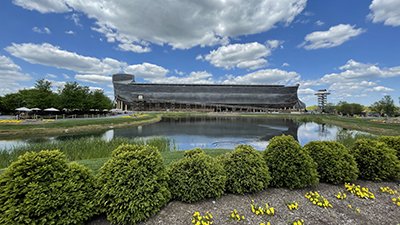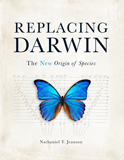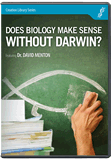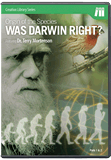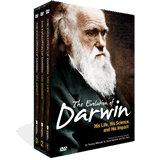
Harvard-Educated Biologist Re-opens Shut Case in Provocative New Book Replacing Darwin
Nathaniel Jeanson, PhD, Challenges 150 Years of Thinking on the Origin of Species with New Scientific Discoveries
Editor’s note: This article was adapted from a news release that was recently distributed to the media.
We’re excited to announce the release of Replacing Darwin, a brand-new book from Answers in Genesis author, speaker, and researcher, Dr. Nathaniel Jeanson (PhD, biology, Harvard). This fascinating new book has a lofty goal—to replace Darwin’s On the Origin of Species with a model of species formation that is based on genetics, observational science, and God’s Word. Replacing Darwin is a must-have resource for every Christian and a great giveaway resource to skeptics or unbelievers, especially scientists.
Since Darwin’s On the Origin of Species was published in 1859, entirely new fields of science have been born and matured—fields which hold the keys to the origin of species. With a Ph.D. in cell and developmental biology from Harvard, Dr. Nathaniel Jeanson is uniquely qualified to investigate what genetics reveals about origins, and has released his findings in the book Replacing Darwin: The New Origin of Species. Replacing Darwin offers a revolutionary approach to the study of origins with a potential impact as big as Darwin’s.
On the Origin of Species is considered one of history’s most influential books and has become the foundation of evolutionary biology. This new work asks readers to consider the question, if Darwin was looking at the same evidence today using modern science, would his conclusions be the same?
“Since 1859, we’ve had time to reevaluate [Darwin’s] picture. A global community of millions of scientists can pool their resources and build on one another’s work,” Jeanson states. “The cumulative observations of these scientists have built an unprecedented body of knowledge on the diversity and operation of life.” In Replacing Darwin, Jeanson argues that this knowledge has rewritten the long-standing explanation for the origin of species.
Though a work of scholarship, Replacing Darwin is accessible. Jeanson uses an analogy to which all readers can relate—a jigsaw puzzle—to illustrate the quest for the answer to the mystery of the origin of species. He contends that Darwin reached his conclusions with only 15 percent—or less—of the total pieces of the puzzle. In addition, Jeanson argues that Darwin tried to piece together his findings without the constraints of edge pieces and corner pieces. If an actual jigsaw puzzle were put together under these conditions, would the participants have had any chance of success?
Jeanson’s book begins its account after the publication of the first edition of Darwin’s book in 1859. The first key discoveries in genetics were not made until several years after Darwin’s seminal work. Furthermore, Jeanson notes, “The physical basis for heredity—the nature of the code of life—was not uncovered until nearly 100 years after Darwin wrote On the Origin of Species.” He adds,
Without this genetic knowledge, could Darwin have speculated intelligently on the origin of species? If he had no idea how traits were coded and inherited each generation, could he have identified the origin of a particular trait? Before the advent of genetics, would his explanation have had any hope of being accurate? . . . When Darwin wrote his most famous work, he took a scientific risk of massive proportions.
Jeanson argues that Darwin’s risk was magnified by several developments outside the field of genetics. Darwin’s original arguments leaned heavily on the fossil record, on the geographic distribution of species, and on comparisons of these species at the anatomical and embryological levels. Jeanson chronicles advances in each of these fields that recast Darwin’s original conclusions.
These advances served to underscore the significance of recent genetic findings. When the human genome was finally mapped in 2001, it became possible for the first time to reach the answer to the bigger origins question. “Since traits are ultimately encoded by DNA, the origin of species is a question of the origin of DNA differences within and between species,” Jeanson explains. “The answer to this question reveals whether a fish can spawn a spider—and whether it ever did . . . . In other words, the answer to the origin of species can be uncovered for the first time right now.”
Building on this groundwork, Jeanson goes on to explore how DNA works, modifying traits from generation to generation until a new species appears. By studying the timing of this rate of change for a variety of species whose DNA has been mapped, he developed mathematical formulas to predict how long before a new species would develop, as well as the number of DNA changes we should have been able to observe in the millions of years (according to the evolutionary timetable) since humans appeared on the scene.
Again and again, his calculations based on observable, quantifiable change failed to fit what we see in the world today when multiplied over millions of years. However, when computed according to a new timescale of 6,000 years, the numbers matched.
In at least five independent measurements of the mutation rate . . . the evolutionary model failed to predict modern DNA differences.
“In at least five independent measurements of the mutation rate—in humans, roundworms, fruit flies, water fleas and yeast—the evolutionary model failed to predict modern DNA differences,” Jeanson’s revolutionary study reveals. “Consequently, the evolutionary failure becomes all the more difficult to dismiss as a statistical or biological anomaly. Instead, the results suggest a systematic problem with the evolutionary model.”
Jeanson concludes that there is much more to be discovered in this field, with the genetics of millions of species yet to be determined and the mutation rates of each of these species to be measured. He expects that connections will be found between many other species within a family (or genus), but that species from different families (or genera) reside in completely different puzzles sharply disconnected from one another, rather than pointing to universal common ancestry.
With this new book, the scientific revolution to overturn Darwin may have begun.
More information is available at our online store.
Recommended Resources

Answers in Genesis is an apologetics ministry, dedicated to helping Christians defend their faith and proclaim the good news of Jesus Christ.
- Customer Service 800.778.3390
- © 2024 Answers in Genesis


